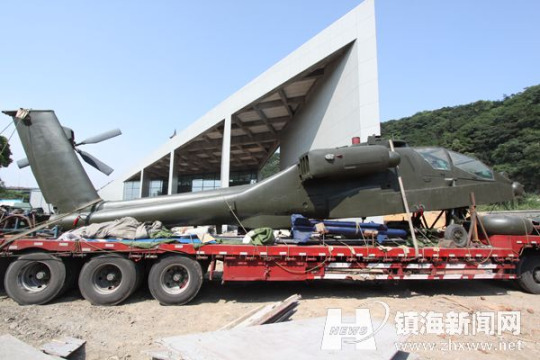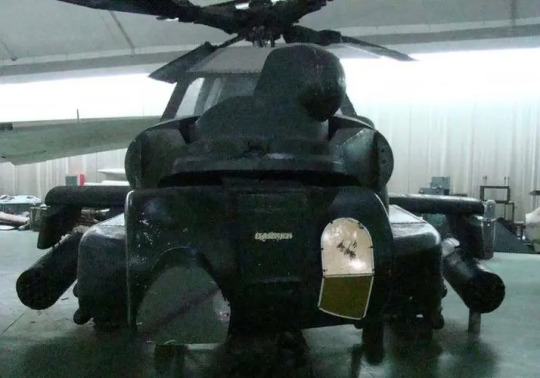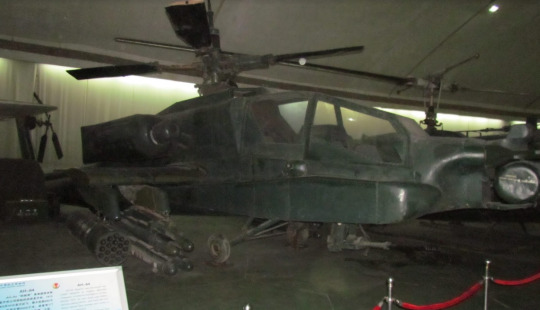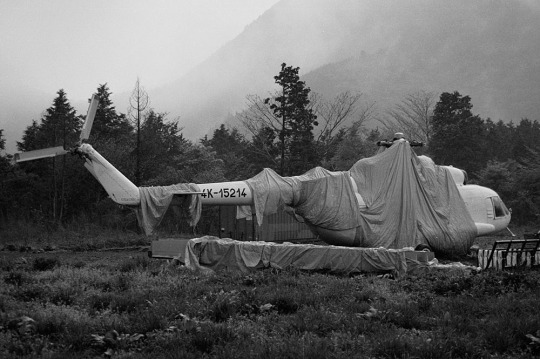Text

In 2013, images appeared in Western media of what appeared to be an AH-64 Apache attack helicopter being transported by an semi at a rest stop in China.
Rumors swirled about the aircraft - was it the Apache that had been shot down at the 2003 Battle of Karbala? Was it a perfect clone of the aircraft made for the People's Liberation Army? Was it an Egyptian Apache shot down by militants in the Sinai and later smuggled to China? None of these, it turns out.
There is no evidence that China has ever successfully captured or purchased an AH-64, intact or damaged. It is true that a Apache helicopter was forced down due to hydraulic failures at the Battle of Karbala in 2003, resulting in the capture of both the pilots and the airframe by Iraqi militia forces. The Apache's crew, David Williams and Ronald Young, were taken to Baghdad and held alongside other captured American service members, including Jessica Lynch. They were rescued by special forces soldiers on April 13th, 2003, in the first successful POW rescue mission since the Second World War. Their aircraft, 99-5135, was visually in relatively good shape when captured by Iraqi forces and shown on Iraqi state television. However, following international news media coverage, its location was revealed, subsequently leading to its destruction by coalition strike aircraft. This eliminates the possibility that the Apache on display above is 99-5135.


As for the Sinai theory, many netizens posited online that the aircraft was Egyptian in origin thanks to the particular hue of the paint. There is no indication that VNSA's in the Sinai have ever successfully shot down an Egyptian Apache (much less contacted a foreign government and successfully smuggled it out of the country without interference from Egypt or the United States.) VNSA's in the Sinai do possess MANPADS, however, and have reportedly a downed an Egyptian government Mi-8/17.

In reality, this aircraft is a type of clone, albeit a non-flying one. This particular replica arrived at the China Air Defense Expo Park (中国防空博览园) in Ningbo, China in mid-2011 according to local media. News articles about the arrival very clearly state that the Apache is a replica. Images of its arrival show it on the same trailer from the news articles published in 2013. It is likely that the images shown in the 2013 articles were taken in 2011 and simply surfaced two years later in a popular article by Western aviation outlet The Aviationist. The Ningbo Apache is is on display near the entrance to the park, next to some conventional AAA guns, although its display area has been renovated a few times since its arrival. Recent images from the park show the Ningbo Apache in a state of disrepair, likely suffering damage from accelerated rust due to its proximity to the Pacific. Notably, Ningbo's Air Defense Expo Park is also home to a full scale replica of the PLAAF's own Chengdu J-10 multirole fighter.





It is likely that the Ningbo Apache shares its lineage with a similar replica at the China Aviation Museum (中国航空博物馆). This replica was built by a PLA colonel, Meng Yifeng, in his spare time according to a plaque on site. While not a perfect replica of the Apache, it is visually quite close. Unlike the Ningbo Apache, the replica at the China Aviation Museum lacks a (replica) AN/APG-78 Longbow radar system. The aircraft is now on display in the cavern that once served as an underground aircraft hangar during the facility's life as Shahezhen Airbase. Why the Chinese government has seen fit to display these replicas so prominently is unclear, as they are non-flying, imperfect clones of the American gunship. Neither replica is claimed to represent an actual Apache, captured or otherwise.




#next time will not be a helicopter i promise#military#military history#people's liberation army#china#ah 64#osint#helicopter#us army#history
29 notes
·
View notes
Text


Mi-17 4K-15214 of doomsday cult and terrorist organization Aum Shinrikyo.
In 1992, Aum Shinrikyo established a foothold in Russia with the assistance of Oleg Lobov, a politician in the newly formed Russian government who sought assistance from Aum's leader Shoko Asahara for the funding of a new Japanese school in Russia. Kiyohide Hayakawa, with the help of Lobov, was able to make connections within the Russian defense apparatus. He, along with a delegation of other Aum members, received training from Spetsnaz units, acquired a number of Soviet military manuals that had been translated into Japanese and managed to procure a brand new AK-74 assault rifle. The rifle was successfully smuggled back to Japan and was used as a model for Aum's own production of the AK-74 at a secret Aum weapons factory in Kanazawa.

Kiyohide's group also returned with 4K-15214, a 1992 manufacture Azerbaijani Mi-17 military transport helicopter painted in flash white. Kiyohide's group carefully documented their exploits in Russia, and a recording of their expedition eventually fell into the hands of Japanese police officials. It is viewable (in part) in this Japanese TV documentary: https://youtu.be/bFwpKPNdLCM
Originally manufactured for the Soviet armed forces under the registration number CCCP-152, the helicopter was transferred to Azerbaijan Air following the dissolution of the Soviet Union. Re-registered as 4K-15214 in civilian service in Azerbaijan, Aum legally imported the helicopter to Japan in 1994.
4K-15214 was intended to be used as a delivery system for chemical weapons over Tokyo, presumably using modified crop dusting equipment. Aum also purchased two radio-controlled helicopters (apparently under the codename "Hercules") with the goal of using them to remotely spread Sarin or other chemical agents. After both of the Hercules helicopters crashed during testing, Aum appears to have given up on the aerial spraying of chemical weapons entirely, instead opting for less complex methods.
Early attempts to spray Sarin utilized pesticide sprayers, but these proved unreliable. Aum eventually used a modified refrigeration truck to spread poison gas, but when this also failed to have the desired effect, individual cult members were selected to deliver the agents by hand. On March 20, 1995, members of Aum entered the Tokyo Metro carrying liquid Sarin in plastic bags wrapped with newspaper. Each Aum member laid their pouches in predetermined locations before puncturing them with the tip of an umbrella. The poison gas flooded the cramped train cars and subway tunnels killing 14 people and injuring hundreds more. It remains the deadliest terrorist attack in Japan's history and the deadliest act of chemical terrorism ever.
Investigators immediately suspected Aum Shinrikyo was behind the attack. Shortly thereafter, members of the Japanese police and Self Defense Forces (including members of the JGSDF's 1st Airborne Brigade) personnel raided Aum's headquarters in Kamikuishiki, where they unearthed not only Aum's weapons-of-mass destruction production facility, but 4K-15214 as well.


The Mi-17 was seized by police, partially disassembled and left in storage outdoors for some time while the trials against Aum progressed. In 1998, 4K-15214 was sold (at a low price) by the Japanese government to Djibouti and reregistered as J2-MAW. It entered service with the Djibouti Air Force (DAF) in 2001. It was repainted in a dark green at some point after the transfer, and now bears a desert scheme.

179 notes
·
View notes